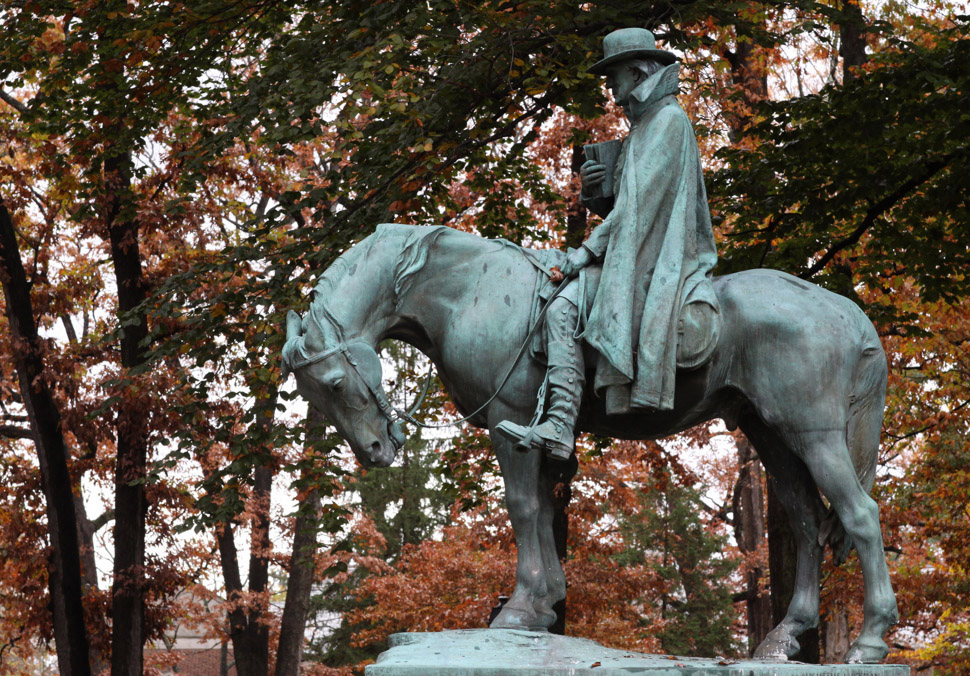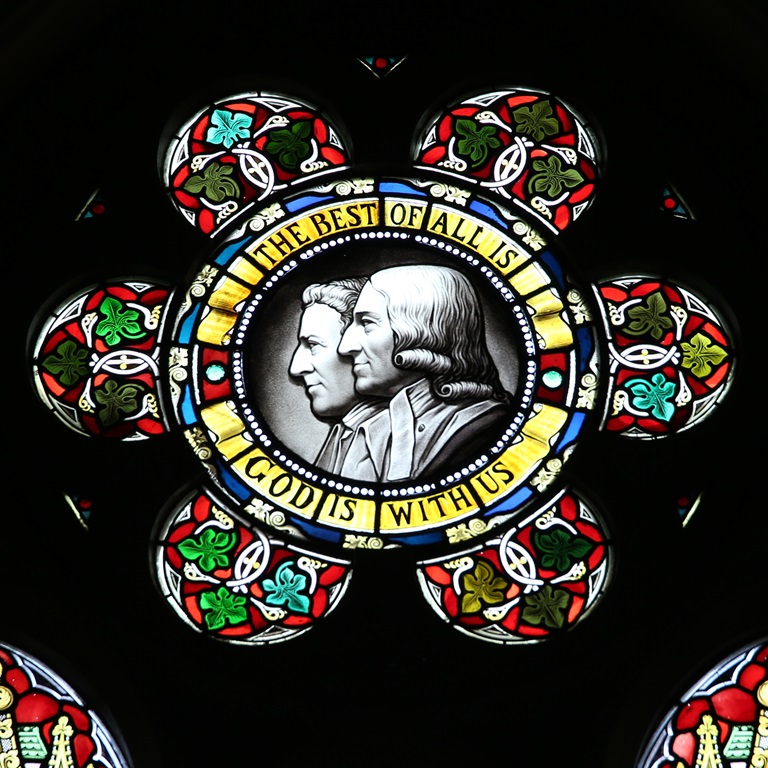A United Methodist ... has a story
The United Methodist Church in 2017 is a product of a worldwide mission that began some 300 years ago. It starts in England, travels to the American continent with the colonists and quickly spreads around the globe.

This oil portrait of the Rev. John Wesley hangs in the Great Hall at Christ Church Cathedral in London. Photo by Kathleen Barry, United Methodist Communications
1725-50: A movement begins
An Oxford Fellow, John Wesley was ordained a priest in the Church of England in 1728. He and brother Charles were sons of an Anglican clergyman the Rev. Samuel Wesley and Susanna Wesley, a woman of great strength, faith and character. In 1729, Charles Wesley formed a small group at Oxford, known as the Holy Club. John soon became leader of the group, which he later regarded as the first expression of Methodism.
As he led others, John struggled with assurance of his own salvation. In 1736, the Wesley brothers embarked on an ill-fated missionary trip to Georgia. John left Georgia in disgrace, but with deep admiration for the Moravians he met on the voyage to America.
On May 21, 1738, Charles had a life-transforming experience. Three days later, on May 24, during a service at a church on Aldersgate Street in London, John felt his heart "strangely warmed" and became assured of his salvation. Soon after, his friend and revivalist George Whitefield convinced him to preach in the fields. John was soon preaching to miners, farm workers, day laborers and others who often found themselves less than welcome inside church buildings. John organized the converts into societies, bands and classes. He began training lay preachers to lead them. In 1744, John initiated the first annual conference to bring together his preachers.
1751-75: Crossing the ocean
As the movement grew, so did pressures to separate the Methodists from the Church of England. John Wesley refused – and remained an Anglican priest until his death. The Wesleyan movement spread to America and in 1771, Francis Asbury arrived to begin 45 years of ministry, much of it to people on the frontier. Among those with whom Asbury bonded was Philip William Otterbein, a German clergyman. Emigrating from Ireland and providing leadership to what would become the Methodist Episcopal Church were Philip and Margaret Embury and Paul and Barbara Heck. New York's Wesley Chapel opened in 1766. It is still an active congregation – John Street United Methodist Church. The first annual conference was in Philadelphia in 1773. William Watters became the first native-born American itinerant preacher.
1776-99: A church is born
John Wesley utterly opposed the American Revolution. In the aftermath, with American Methodists having few options to receive the sacraments, Wesley appointed lay preachers Richard Whatcoat and Thomas Vasey for ministry in America and commissioned Thomas Coke as superintendent of America's Methodists. Wesley charged Coke to commission Asbury to serve with him as Wesley's deputies. Asbury refused to accept the assignment unless he was elected by the free vote of the American preachers. His election came in the Christmas Conference of 1784, and the Methodist Episcopal Church was born. 1785 saw the first Book of Discipline published.
The young Methodist Episcopal Church experienced its first division in 1787 as some African-American members left. They would form the African Methodist Episcopal Church in Philadelphia and the African Methodist Episcopal Zion Church in New York.
Missions began reaching the Channel Islands, France and Spain.

This statue of Bishop Francis Asbury on the campus of Drew University in Madison, N.J. Photo by Kathleen Barry, United Methodist Communications
1800-25: The church grows
Asbury, now calling himself bishop, was the undisputed leader of the American Methodists until his death in 1816. 1808 brought the denomination's first Constitution, a publishing house and revivalism and camp meetings to draw new converts.
While Asbury led the growth of Methodism into the frontier, Otterbein and Martin Boehm founded The United Brethren in Christ. Daniel Coker organized a Methodist Society for freed slaves headed to Liberia. Missionaries traveled to Australia, the Dominican Republic, Gambia, Haiti, India, Sierra Leone, South Africa and Tonga.
1826-50: Growth and division
American Methodism was part of The Second Great Awakening. Local churches and classes sprung up wherever a few women and men gathered under the direction of class leaders and lay preachers. Ordained circuit riders visited regularly and administered the sacraments. The Sunday school movement began to flourish.
In the same years, divisions over slavery deepened resulting in schism at the 1844 General Conference. In 1845, delegates from the Southern states organized the Methodist Episcopal Church South. It was not the first division in the young church over social and theological issues. The Methodist Protestant Church was founded in 1828 and The Wesleyan Methodist Church in 1841.
Methodist missions were established in Argentina, Brazil, China, Dehomey (Benin), Fiji, Germany, Ghana, Liberia, Samoa, Sweden, Switzerland and Togo.
1851-75: War and the aftermath
The American Civil War took a heavy toll, especially in the South, although both churches eventually rebounded. The Freedmen's Aid Society and the Colored (now Christian) Methodist Episcopal Church organized to serve the newly freed slaves. The Methodist Episcopal Society organized in Denmark, and the Free Methodist Church of North America began in New York.
Helenor M. Davisson was ordained deacon in 1866 in the Methodist Protestant Church, the first clergywoman in the Methodist tradition.
Methodism reached Austria, Bulgaria, Finland, Hawaii, Italy, Japan, Kenya, Mexico, Myanmar (Burma), New Guinea, Norway, Portugal and Uruguay.
1876-1900: Missions and Dreams
Both the northern and southern churches emphasized mission work in the United States and internationally. Missionaries established schools for former slaves and their children. Women began forming missionary societies and raising funds. Missionaries Isabella Thoburn, Susan Bauernfeind and Harriett Britten and administrators Belle Harris Bennett and Lucy Rider Meyer motivated churchwomen to support home and foreign mission.
The push began for increased participation in decision-making by laity and women.
Bishop William Taylor worked in Angola, Bolivia, Chile, Democratic Republic of Congo and Peru. Bishop James M. Thoburn pioneered ministries in Malaysia and the Philippines. Thoburn founded the first Christian women's college in India. Methodist missions spread to Costa Rica, Cuba, Hungary, Korea, Mozambique, Nigeria, Puerto Rico, Rhodesia (Zimbabwe) and Russia.
In 1898, Bishop Joseph Crane Hartzell stood atop Mount Chiremba in then Rhodesia and dreamt of hundreds of African youth running to school in the valley below.
1901-25: Healing begins
The churches began to heal some of the early schisms. The Evangelical Association and the United Evangelical Church became The Evangelical Church in 1922. While there was growing theological ferment between liberal Protestant theology, fundamentalists and a conservative group termed neo-orthodox, Methodists worked together in mission.
In 1908, the Methodist Episcopal Church adopted The Social Creed to express outrage over the miserable lives of millions of workers.
Methodist missionaries reached Albania, Belgium, Borneo, Czechoslovakia, Estonia, Java, Latvia, Lithuania, Manchuria, Panama, the Philippines, Poland, Serbia and Sumatra. The Primitive Evangelical Methodist Church of Guatemala formed. Hartzell launched missions in Algeria and Tunisia.
1926-1950: Coming together
The push toward reunification continued as The Methodist Episcopal Church, The Methodist Protestant Church and The Methodist Episcopal Church South forged a plan of union. The final proposal included dividing a united church into six administrative units, called jurisdictions. Five were geographical. One, the Central Jurisdiction, was racial, including African-American churches and annual conferences wherever they were located in the United States. Though troubling to many, the proposal was accepted. The three churches united in April 1939 to become The Methodist Church (USA).
Missions extended into Burundi and Rwanda. The North Africa Provisional Conference was established.
In response to World War II's devastating effects, the 1940 General Conference of The Methodist Church approved forming the Methodist Committee on Relief.
1951-75: Uniting and united
In 1951, The Methodist Church helped form the World Methodist Council. Ties established with the World Council of Churches and the National Council of Churches allowed for greater cooperation in mission and other ministries.
The Methodist Church was increasingly concerned with the issue of racism in the church and United States. While earlier General Conferences considered proposals to eliminate the Central Jurisdiction, it continued until its abolition became part of the proposed union with the Evangelical United Brethren.
Full clergy rights for women were also part of the plan of union. The Methodist Church agreed to full clergy rights for women in 1956, but it took more than a decade for the number of women in seminaries to increase.
In 1968, General Conference approved the proposal to create The United Methodist Church. Merging and reorganizing structures followed. Many of today's general agencies had their beginning.
Meanwhile, congregations flourished in Taiwan and Zambia. The European Methodist Council, the Council of Evangelical Methodist Churches of Latin America and the Burundi Conference were established.
1976-2000: Years of progress
As an increasing number of women were admitted to ordained ministry, Marjorie Matthews was elected the first female United Methodist bishop in 1980, and Leontine T.C. Kelly became the first female African-American bishop in 1984. The first African bishop, Abel T. Muzorewa, became prime minister of Zimbabwe.
Hartzell's dream of African youth running to school took a step toward reality when General Conference 1988 approved establishing Africa University in Old Mutare, Zimbabwe. Opened in 1992, it continues to draw a diverse body of students from throughout Africa.
New churches emerged in Colombia, El Salvador and Vietnam. Central and Southern Europe Bishop Heinrich Bolleter and the United Methodist Committee on Relief aided Kosovo.
2001-present: Into the future
The church continues to experience change and increasingly knows itself as a world church with members and conferences in Africa, Asia, Europe and the United States. While membership in Europe and the United States has declined, it has grown significantly in Asia and Africa. The church endeavors to become a community in which all people, regardless of racial or ethnic background, can participate in every level of its connectional life and ministry (The Book of Discipline, Historical Statement, p. 22).
The Protestant Methodist Church of Cote d'Ivoire (Ivory Coast) joined The United Methodist Church in 2004. In 2008, General Conference entered into full communion with The Evangelical Lutheran Church in America. United Methodists responded to devastating earthquakes in Haiti and Japan and to other disasters.
In 2012, the General Conference participated in "An Act of Repentance toward Healing Relationships with Indigenous Peoples." The church also entered into communion with several historically African-American pan-Methodist denominations, made United Methodist Women an autonomous organization and created a national ministry plan for Pacific Islanders in the United States.
General Conference 2016 approved five new bishops for Africa in 2020 and provisional central conferences in Southeast Asia and Mongolia and a provisional annual conference in Rwanda. For the first time, a member from outside the United States, N. Oswald Tweh Sr., a layman from Liberia, is president of the Judicial Council, the denomination's "supreme court". He will hold the office until 2020.
Views on human sexuality continue to be divisive in the worldwide church. General Conference 2016 accepted a Council of Bishops' proposal to defer debate on these issues until after a period of study and discussion by a special commission. A special General Conference dedicated to the topic has been called for February 2019.
Adapted from Therefore, Go: A Handbook for United Methodists, a publication of United Methodist Communications.
Originally published in Interpreter Magazine, May–June , 2017.

